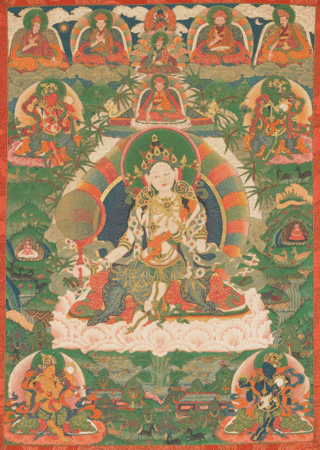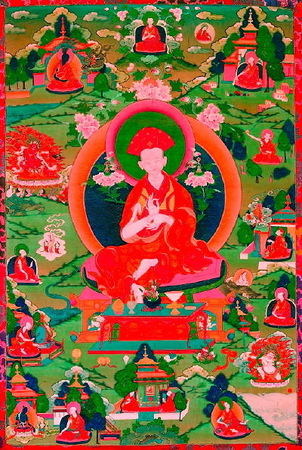"Au pays du Dragon : arts sacrés du Bhoutan" @ Musée Guimet, Paris
La protectrice du Dharma Dorje Yudrönma , XIXe siècle. Encre et couleurs minérales sur coton. H. 152 cm ; L. 81 cm. Gönpa de Phajoding, Thimphu. Crédit photographique : © Shuzo Uemoto
Cette exposition réunit pour la première fois une centaine d’œuvres bouddhiques prêtées par divers temples et monastères du Bhoutan, royaume himalayen situé entre le Tibet et l’état indien de l’Assam, et qui constitue une enclave miraculeusement préservée et vivante du bouddhisme tibétain. Objets de culte, ces pièces n’avaient jamais pour la plupart été présentées en dehors du Bhoutan. Composée d’une majorité de thangkas, peints ou brodés, parfois de très grandes dimensions, mais aussi de sculptures métalliques et de quelques objets liturgiques, s’échelonnant du VIIIème au XIXème siècle, l’exposition permettra d’évoquer les traditions artistiques bhoutanaises et ses développements historiques, encore mal connus, à travers divers thèmes iconographiques du bouddhisme tantrique. Il s’agira d’illustrer aussi la diffusion de celui-ci au Bhoutan par l’intermédiaire de grands maîtres indiens et tibétains ainsi que les principales figures religieuses qui jalonnèrent l’histoire du pays. Une série de films exceptionnels et inédits, tournés dans le pays, consacrés aux danses bouddhiques rituelles ou cham, accomplies par les moines lors de certaines grandes fêtes, complètera l’exposition. En outre, deux moines bhoutanais qui accompagneront celle-ci, exécuteront des rituels journaliers, dans un espace aménagé pour l’occasion au sein du musée, et qui sera accessible au public.
L’exposition est aussi une manière de célébrer le centenaire du règne de la dynastie Wangchuck et l’adoption par le Bhoutan, en 2008, de sa première constitution
Jamgön Ngawang Gyaltsen (1647-1732), XVIIIe siècle. Thangka appliqué et brodé Soie. H. 334 cm ; L. 220 cm. Dzong de Trashichö, Thimphu. Crédit photographique : © Shuzo Uemoto
This exhibition was conceived by the Arts Academy of Honolulu, together with the Culture Department of the Royal Bhutanese Government and the Central Monastery Authority, and is a big premiere in the Western world. It invites the public to discover works which to this date had never been presented outside of the Bhutanese borders. The exhibition is also an opportunity for the muse'e Guimet to get associated to the celebration of the centennial of the Wangchuk dynasty's reign and the adoption by Bhutan in 2008 of its first constitution.
The major themes of tantric Buddhism
By bringing together for the first time an ensemble of over one hundred Buddhist pieces that have remained objects of worship, on loan by more than thirty temples and monasteries in the Bhutan kingdom- located in the Himalayas between Tibet and the Indian state of Assam - the Guimet museum offers the public a unique possibility of discovering the major iconographic themes of tantric Buddhism. Bhutan's official religion is approached by referring to the country's artistic traditions, their historic developments as well as the principal religious figures that peopled its history. This esoteric form of Buddhism was born in India and was transmitted to the Himalayan region, to Tibet and Bhutan, during the VIIIth century. Padmasambhava, the famous master from Swât, today the region North of Pakistan, was then one of the main vectors of this diffusion.
The pieces presented go from the VIIIth to the XIXth centuries, and illustrate in particular the golden age of Bhutanese art between the XVIIth and XIXth centuries, rich with a complex and subtle iconography. The exhibition presents a rare ensemble of painted or embroidered thangkas, some of them with very large dimensions, as well as metallic sculptures and liturgical objects. Dance, which occupies an important place in tantric Buddhism iconography, is evoked in the excerpts from movies filmed in Bhutan and shown during the exhibition. These ritual Buddhist dances, or cham, performed during celebrations, have been preserved in the country at an unequaled pure state, and some of them are linked to figures largely referred to through the works in the exhibition, such as Padmasambhava.
An enduring fascination
The exhibition is accompanied by photographs that prove the fascination exercised by Bhutan and this unique spirituality. Near the exhibition galleries, on the ground floor giving to the garden, we can admire coloured photographs taken in Bhutan by the monk Matthieu Ricard, the author of a recent work on the Himalayan kingdom where he has often resided. The Lacquer Rotonda (Rotonde aux Laques), on the last floor of the museum, offers another choice of original photographs, in black and white, taken and developed directly by Jean Timsit, with a folding camera with a bellows.
Publication:
Au pays du Dragon: arts sacre's du Bhoutan, (In the country of the Dragon: sacred arts of Bhutan) catalogue of the exhibition-Editions RMN/ Muse'e Guimet, 392 p., 50 -. With a DVD of ritual dances. The authors wished to underline the stylistic and iconographic elements that contribute to distinguish the Bhutan works from the Tibetan ones, thus marking an important phase in the development of the studies on the subject.
"Au pays du Dragon : arts sacrés du Bhoutan" Musée Guimet
Le Shabdrung Ngawang Namgyal (1594-1651), XIXe siècle. Alliage de cuivre doré, dorure à froid et pigments. H. 39 cm ; L. 31 cm ; Pr. 24 cm. Gönpa de Trashigang, Thimphu. Crédit photographique © Michael Tropea

/https%3A%2F%2Fprofilepics.canalblog.com%2Fprofilepics%2F1%2F0%2F100183.jpg)
/https%3A%2F%2Fstorage.canalblog.com%2F03%2F02%2F119589%2F96711876_o.jpg)
/https%3A%2F%2Fstorage.canalblog.com%2F11%2F31%2F119589%2F94773502_o.jpg)
/https%3A%2F%2Fstorage.canalblog.com%2F20%2F83%2F119589%2F94772815_o.jpg)
/https%3A%2F%2Fstorage.canalblog.com%2F26%2F72%2F119589%2F75604929_o.jpg)
/https%3A%2F%2Fstorage.canalblog.com%2F59%2F60%2F119589%2F26458628_o.jpg)






/http%3A%2F%2Fstorage.canalblog.com%2F31%2F18%2F119589%2F120437734_o.jpg)
/http%3A%2F%2Fstorage.canalblog.com%2F24%2F74%2F119589%2F120437074_o.jpg)
/http%3A%2F%2Fstorage.canalblog.com%2F29%2F81%2F119589%2F120373953_o.jpg)
/http%3A%2F%2Fstorage.canalblog.com%2F39%2F08%2F119589%2F112364211_o.jpg)